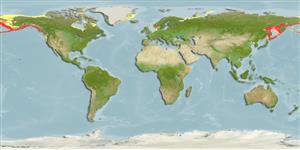Environment: milieu / climate zone / depth range / distribution range
Ecología
marino batidemersal; rango de profundidad 25 - 925 m (Ref. 6793). Deep-water
North Pacific: Point Hope, Alaska in the Chukchi Sea to Peter the Great Bay in the Sea of Japan, Agattu Island in the Aleutian chain and Oregon, USA.
Tamaño / Peso / Age
Maturity: Lm ? range ? - ? cm
Max length : 51.0 cm TL macho / no sexado; (Ref. 2850)
Short description
Morfología | Morfometría
Espinas dorsales (total): 0; Radios blandos dorsales (total): 94-105; Espinas anales 0; Radios blandos anales: 83 - 90. Caudal fin narrowly rounded but not distinguishable from dorsal and anal fins. Pelvic fins minute.
Found on muddy or sandy bottoms (Ref. 2850). Feeds on small bivalves and shrimps (Ref. 6885).
Life cycle and mating behavior
Madurez | Reproducción | Puesta | Huevos | Fecundidad | Larva
Eschmeyer, W.N., E.S. Herald and H. Hammann, 1983. A field guide to Pacific coast fishes of North America. Boston (MA, USA): Houghton Mifflin Company. xii+336 p. (Ref. 2850)
IUCN Red List Status (Ref. 130435)
Threat to humans
Harmless
Human uses
Más información
Age/SizeCrecimientoLength-weightLength-lengthLength-frequenciesMorfometríaMorfologíaLarvaDinámica larvariaReclutamientoAbundanciaBRUVS
ReferenciasAcuiculturaPerfil de acuiculturaRazasGenéticaElectrophoresesheritabilidadEnfermedadesProcesamientoNutrientsMass conversion
ColaboradoresImágenesStamps, Coins Misc.SonidosCiguateraVelocidadTipo de nataciónSuperficie branquialOtolitosCerebrosVisión
Herramientas
Special reports
Download XML
Fuentes de Internet
Estimates based on models
Preferred temperature (Ref.
123201): 0.2 - 6.3, mean 2.2 °C (based on 305 cells).
Phylogenetic diversity index (Ref.
82804): PD
50 = 0.5000 [Uniqueness, from 0.5 = low to 2.0 = high].
Bayesian length-weight: a=0.00120 (0.00057 - 0.00252), b=3.10 (2.91 - 3.29), in cm total length, based on LWR estimates for this (Sub)family-body shape (Ref.
93245).
Nivel trófico (Ref.
69278): 3.5 ±0.3 se; based on diet studies.
Resiliencia (Ref.
120179): Muy bajo, población duplicada en un tiempo mínimo superior a 14 años (Preliminary K or Fecundity.).
Fishing Vulnerability (Ref.
59153): Moderate vulnerability (40 of 100).
